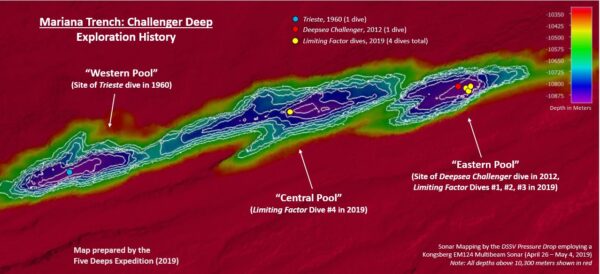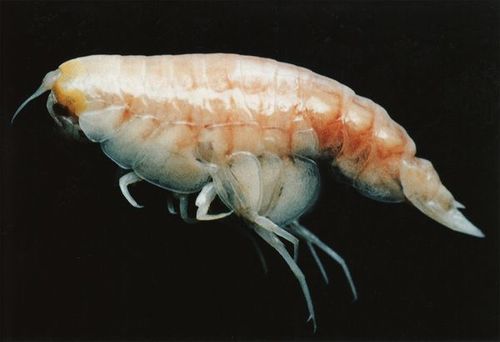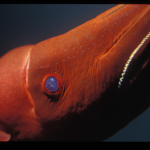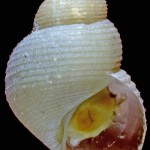
The highest known pressure in the deep oceans coincides with the maximum known depth in the southern end of the Mariana Trench, the Challenger Deep. The actual maximum depth of Challenger Deep is disputed. The deepest reported measurement was by a Russian research vessel at 11,034 m. The International Hydrographic Organization adopted 10,924 in 1993, but a subsequent 2010 survey, and the most accurate, places the depth at 10,984 – 25 m greater. With every 10 m corresponding to 1 atmosphere of pressure, this places the maximum known pressures in the deep between 1092.4 and 1103.4 atm (110.7–111.8 MPa). Notable is that several other deep-sea trenches—Tonga, Philippines, KurilKamchatka, and Kermadec—in the Pacific Ocean also reach depths >10,000 m. In the Atlantic Ocean, the two deepest trenches are the Puerto Rico Trench at 8800 m and the South Sandwich Trench at 8428 m.

The prevalence of prokaryotic and eukaryotic life through the range of high pressures in the deep oceans suggests that organisms can easily adapt to these conditions. Even at the extreme pressures (>110 MPa) in the Challenger Deep, microbial life flourishes and differs from the background abyss. Several large multicellular organisms have been found at extreme depths and pressures and can be characterized as primarily hadal and trench species. Endemism of species occurring greater than 7000 m is 74% of surveyed species, implying a strong evolutionary pressure and the unique adaptations required to exist at extreme depths. Among invertebrates, several reach trench depths, including the sea cucumber Myriotrochus bruuni at 10,710 in the Mariana Trench, the extremely abundant amphipod Hirondellea gigas at 10,897 m in the Challenger Deep, the isopod Macrostylis species at 10,710 in the Mariana Trench, the polychaete genus Macellicephaloides at 10,700 m depth, and the sea anemone family Galatheanthemidae at 10,700 m depth. The deepest known vertebrate is the hadal snailfish Pseudoliparis swirei found at 7966 m.
How do organisms survive this deep?

- Cell membranes: As you may remember from high school or college biology, a cellular membrane consists of lipid bilayer. The structure is entirely maintained by the interaction of charges (or lack of) between water and the phospholipids. This makes the membrane semipermeable much like a layer of oil on water. Extreme pressure results in a tighter packing of the phospholipids which lowers the permeability of the membrane. One adaptation by deep-sea animals is to increase cellular permeability is to increase the percentage of unsaturated fatty acids. In a saturated fatty acid all the carbons in the chain are lined by a single covalent bond. As you recall, a carbon can take four chemical bonds. If all these bonds are covalent (single) then a carbon could potentially attach to 4 other atoms. Thus the saturated comes from the fact that the carbon chain is loaded with hydrogens. If a carbon forms a double bond with another atom then the carbon would have to bond with one less hydrogen. Thus an unsaturated fatty acid is one with double bonds and not ‘saturated’ with hydrogens. The double covalent bond between adjacent carbons in an unsaturated fatty acid leads to a ‘kink’ in the tails of the molecule. Thus increasing their concentration in membrane leads to a looser packing.
- Enzyme shape: At the basic level, pressures would also select for different enzymes. Changes in protein structure can influence their cellular function. Thus selection for rigidity is needed to counteract pressure and the resulting warping of proteins. Proteins contain hydrogen and disulfide bonds between different subunits and parts of the amino acid chain that both dictate structure. A selection for proteins with increased bonding would minimize changes in shape to do pressure.
- Urea: As note by Al Dove previously, “Pressure can even make molecules more (or less) toxic. Urea is a good example: it becomes far more toxic as pressure increases. So deep sea sharks, which like all sharks have a lot of urea in their blood, also have a lot more of the protective chemical TMAO to offset this effect than do their shallow water cousins.”
- Air filled sacs: Basically this is bad for an animal under pressure, so most deep-sea animals avoid having them. Deep-sea fish lack swim bladders. Other deep diving animals like whales and seals have collapsible lungs to deal with extreme pressure (not to mention a whole host of other adaptations)! Penguins basically shut down all their organs except for their heart and their brain when doing deep dives.
Share the post "The Hidden World of Extreme Ocean Depths: Life and Pressures in the Trenches"





